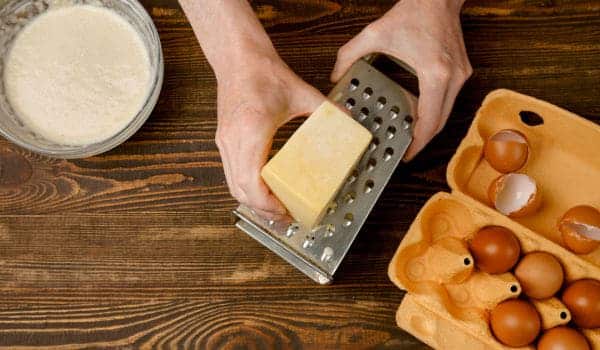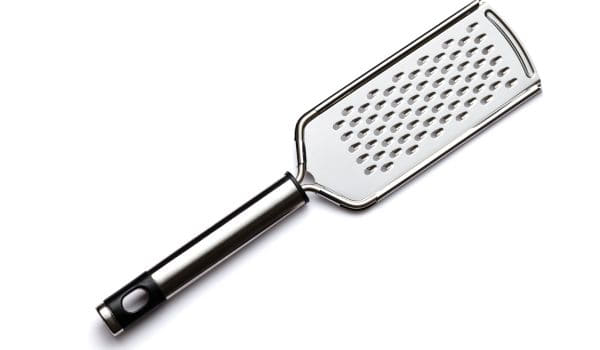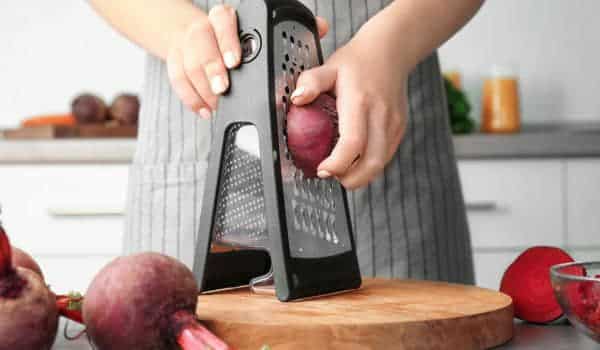A grater is a kitchen utensil designed with sharp-edged holes or blades used to shred or grate various foods into smaller, uniform pieces or fine shavings. Its primary purpose in the kitchen is to efficiently break down ingredients like cheese, vegetables, fruits, or spices into desirable textures for cooking or garnishing dishes.
Graters play a fundamental role in food preparation by simplifying the process of creating consistent sizes or obtaining specific textures required in different culinary applications.
What foods can I grate using a grater?

Graters are versatile tools used to grate a variety of foods such as cheese (hard or soft), vegetables like carrots, potatoes, or zucchini, fruits like apples or citrus for zest, as well as nuts, chocolates, and spices.
How do I use a grater effectively?

To use a grater effectively, hold the grater securely on a stable surface or against a bowl. Use firm, consistent strokes to grate the food item against the grater’s surface, applying gentle pressure for the desired texture, whether finely grated or coarser shreds.
Description of a grater

Basic structure and design
A grater typically features a flat surface with sharp-edged holes or blades. The surface is often made of metal, and it can be flat or curved, depending on the type of grater. It usually has a handle or a base for stability while grating. The size and arrangement of the holes or blades may vary, allowing for different shredding or grating textures.
Types of graters (box grater, handheld grater, rotary grater)
- Box Grater: This type of grater has multiple sides, each with a different grating surface—commonly coarse, fine, slicer, and zester. It often includes a container at the bottom to collect grated food.
- Handheld Grater: Typically smaller in size, handheld graters offer a single grating surface and are held by hand during use. They are versatile and convenient for smaller tasks.
- Rotary Grater: Operated by turning a handle, rotary graters have a drum-like structure with interchangeable blades and are efficient for grating larger quantities of food.
- Microplane/Zester Grater: These graters have very fine blades, ideal for zesting citrus fruits, grating hard spices. Or obtaining fine shavings of cheese.
Materials used in making graters
- Metal: Stainless steel is a common material for the grating surface due to its durability and resistance to rust. It provides sharp edges for efficient grating.
- Plastic: Some graters have plastic frames or handles, which are lightweight and may include rubber or silicone bases for stability.
Functions and Uses

Shredding cheese
Graters are widely used for shredding various types of cheese, such as cheddar, mozzarella, or parmesan. Different grater types offer varying thickness options, allowing for shredded cheese suitable for different recipes like pizzas, salads, pasta dishes, or casseroles.
Grating vegetables and fruits
Graters are versatile tools for grating vegetables like carrots, potatoes, zucchini, and fruits such as apples or citrus zest. They help create consistent shreds or fine gratings, which can be used in salads, coleslaws, baking, or as garnishes in various dishes.
Zesting citrus fruits
Graters equipped with fine blades or zester graters are specifically designed for removing the outer peel of citrus fruits, known as zest. This zest contains flavorful oils that enhance the taste of dishes such as desserts, sauces, or marinades.
Creating fine shavings of chocolate or spices
Graters with fine grating surfaces are excellent for creating delicate shavings of chocolate or grating hard spices like nutmeg, cinnamon, or ginger. These shavings or grated spices add depth of flavor and aesthetic appeal to desserts, beverages, or savory dishes.
How to Use a Grater

Safety precautions (handling sharp edges)
- Use caution when handling a grater as the blades or edges are sharp. Hold the grater by its handle or base to avoid accidental cuts.
- Always keep fingers away from the grating surface while using the grater to prevent injury. Consider using a protective glove or a food holder for added safety.
Proper technique for grating different foods
- Cheese: Use a firm grip on the cheese and apply even pressure while moving it across the grater’s surface. For better results, keep the cheese cold to prevent it from sticking.
- Vegetables and Fruits: Use a downward motion with steady pressure when grating vegetables or fruits. Hold the food item at an angle against the grater to produce uniform shreds or gratings.
- Citrus Zesting: Gently rub the fruit against the fine blades of a zester grater, rotating the fruit to zest only the outer colored peel. Avoid grating the bitter white pith beneath the peel.
Cleaning and maintenance tips
- Handwash graters immediately after use to prevent food particles from drying and sticking to the blades. Use a brush or sponge to clean the grater thoroughly.
- If dishwasher safe, place the grater in the dishwasher’s utensil basket for cleaning. However, handwashing is generally recommended to prolong the grater’s lifespan.
- To remove stubborn food particles, soak the grater in warm, soapy water before cleaning or use a small brush to reach between the grater’s holes.
- Dry the grater completely after washing to prevent rust or corrosion, especially for metal graters. Store it in a dry place or utensil drawer to maintain its condition.
Importance in Culinary Preparations
Enhancing flavors and textures in dishes
Graters play a crucial role in culinary preparations by enhancing the flavors and textures of various dishes. They allow for the creation of consistent sizes and shapes of ingredients, contributing to the overall taste and presentation of meals. Whether it’s finely grated cheese to add creaminess, zested citrus peels for a burst of flavor. Or grated vegetables to provide texture, graters enable cooks to infuse dishes with nuanced tastes and appealing textures. The ability to control the size and form of grated ingredients helps in achieving the desired balance and depth of flavors in salads, entrees, desserts, and more.
Versatility in food preparation
The versatility of graters in the kitchen is unparalleled. With different types of graters available, they cater to a wide range of culinary tasks. From shredding cheese to grating vegetables, fruits, chocolates, or spices, graters offer flexibility in preparing ingredients for diverse recipes. Their ability to quickly transform foods into various textures whether coarse, fine. Or in between—makes them indispensable tools for chefs and home cooks alike. Graters streamline the cooking process, making it easier to incorporate ingredients into dishes in ways that enhance taste, appearance, and overall cooking efficiency.
Role in various cuisines worldwide
Graters are integral in many cuisines worldwide, contributing to unique dishes and flavor profiles. In Italian cuisine, for instance, finely grated Parmigiano-Reggiano or Pecorino Romano cheeses are staples in pasta dishes and risottos, enhancing their savory richness. In Mexican cuisine, graters are used to shred cheeses for tacos or to grate vegetables like radishes or carrots for garnishes. Similarly, in Asian cuisines, graters are utilized for grating ginger, daikon radish. Or coconut to impart distinct flavors and textures in dishes. The widespread use of graters across cultures underscores their significance in bringing out the essence of various culinary traditions and recipes globally.
Conclusion
Graters stand as indispensable tools in the kitchen, offering versatility and efficiency in food preparation. Their ability to finely shred, grate, or zest various ingredients significantly enhances flavors, textures. And presentations in a multitude of dishes. From effortlessly creating delicate citrus zests to producing uniform cheese or vegetable shreds, graters play a pivotal role in achieving culinary excellence. Their importance lies not only in their functionality but also in their capacity to elevate the taste, appearance. And the overall quality of diverse recipes, makes them an essential and invaluable asset for both professional chefs and home cooks in their culinary pursuits.





